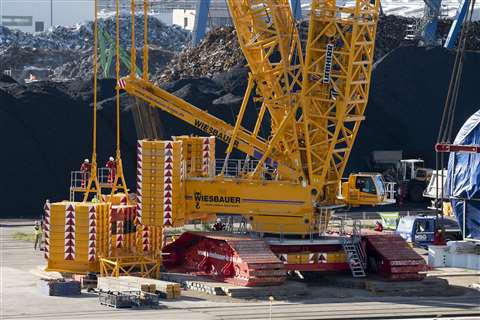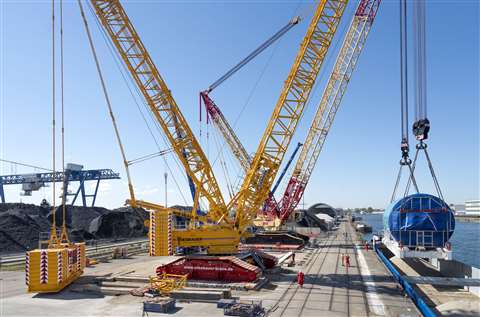Tandem lift using large Liebherr crawlers
24 September 2019
Mammoet Germany, the German subsidiary of Dutch heavy load specialist Mammoet, used two powerful Liebherr crawler cranes, an LR 11350 and an LR 11000, working in tandem to load a tunnel boring machine (TBM) on to a barge at an industrial river port in Germany.

The Liebherr LR 11000; if you look closely you can see two workers securing the suspended ballast pallet containing 450 tonnes of ballast
The port at Kehl, on the German side of the river Rhine in Baden-Württemberg, was the location for the lift of components including the TBM weighing around 950 tonnes built by German construction equipment manufacturer Herrenknecht.

To lift the TBM Mammoet rented the 1,350 tonne capacity LR 11350 from Dutch crane rental company P. van Adrighem, although it was still in the livery of its original owner, Scottish crane contractor Weldex.
The 1000 tonne capacity LR 11000 series was hired from Wiesbauer, a crane service provider based in southern Germany.

The two cranes were transported to Kehl via inland waterway, the LR 11350 coming from Rotterdam and the LR 11000 coming from Mannheim. When they arrived at Kehl they were assembled along with the TBM components which arrived from the Herrenknecht factory 30 kilometres away in Schwanau.
Together the two cranes offered a total lifting capacity of 2350 tonnes (or 37,919 tonne-metres of load moment).

The handling and transportation of the components required the installation of a blade cradle underneath the TBM. The blade cradle also contained fastening points to which the cranes’s steel ropes were secured using shackles.

The Mammoet team required several hours to hoist the TBM onto the barge as they needed to place a further 300 tonnes of steel onto the suspended ballast pallet of the LR 11350 during the slewing process. A considerable number of counterweights were required, outlined Liebherr, because the load had to be lowered into the barge’s hold with a radius of around 30 metres. The large radius was due to the distance between the cranes and the barge based on the structural strength of the loading platform. As a result of the high ground pressure, the load capacity of the ground in this area had to be recalculated to find safe areas for the crawler cranes to be positioned. During the final phase of the hoist, the two cranes had a total of 1600 tonnes of ballast.
Once safely on the barge, they were transported to the Dutch coast. This took five days. From here, they will be shipped to the United Kingdom in November where they will be used in a tunnelling project.
STAY CONNECTED


Receive the information you need when you need it through our world-leading magazines, newsletters and daily briefings.



